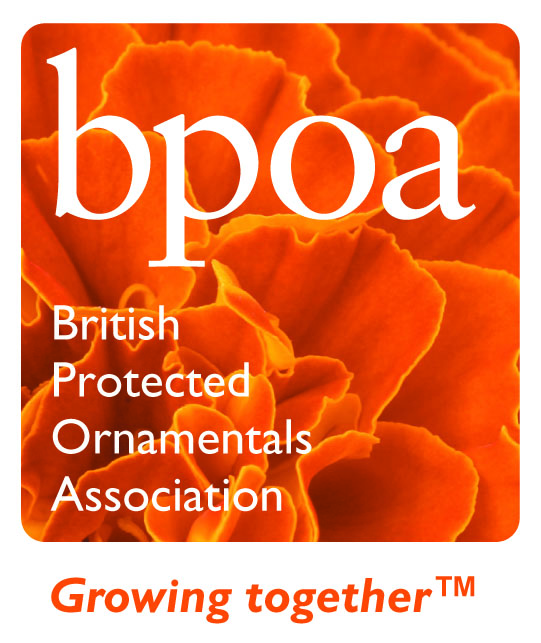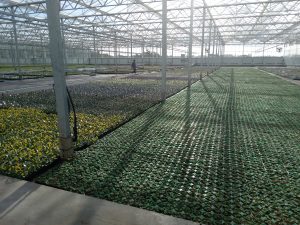Following on from the Automation Tour on the 17th & 18th September, I thought it would be good to share some of the automation we’ve seen-
Vas. Baas
Stand alone packing robot, looked futuristic but was in commissioning phase so we did not get to see it run unfortunately. It should be able to produce 600 boxes an hour and costs approximately €36,000.
100% Biological Pest control.
Not sure which site but one also had a conveyor belt feeding the trays in for the transplanter, in essence giving a buffer which could result in a labour saving.
Beekenkamp
ISO Sticking Robots were very impressive, these were achieving approx. 2,300 per hour, there were still some gaps post planting though.
TTA Gapping Machine, was pushing out existing plugs on trays and positioning established plants/plugs from another tray, good if you have lots of gaps after germination.
TECMEC Cyclamen Grading Machine, sorted into Class A and Class B, can grade up to 9,000 per hour but was achieving 7,440 when I checked.
Seeding lines – Spray from above which I think is standard but also trays submerged to a level so watered from below.
P v.d. Haak
SDF Software/System used to move benches in and out of the Glasshouse, this is a great system that we know KG/Technicon could also deliver. You can query where certain types of plants are etc. and can see at a glance, I have attached some photos showing this.
High Level Automation in place for clean benches, works well, not dissimilar to what we now have at Clay Lake.
Deliflor
30 Sticking Robots producing up to 1 million Mums a day! Heads pick up 1 at a time and deliver 4 at a time to the planting head which plants 8 at once. Excellent system and make best use of robot head reducing travel time.
Good system after the robots, automation allows a carriage to collect trays from various feeds and then load up various tracks, a great buffer solution with very little manual intervention.
Zuidbaak
Compost feeding over conveyors direct to various potting machines etc. A good idea as large amounts of compost can be fed into a single main feed and this also avoids the mix of pedestrian and vehicle movements.
Manually operated cranes in the glasshouse that can pick up entire beds of trays, great if you are laying down on the ground but probably not for us.
A simple tray watering station that a single trolley feeds through, pushed through by wheels like our trolley pusher system. Simple but effective.
Gebr. Grootscholten
SDF Software again as per v.d. Haak, very good.
TTA Machine Transplanting to Javo standard SE potting robot, very effective and could reduce staffing levels by 1 or 2?
Wouters Kwekerij
Visser Transplanter – 5 working heads each with 8 heads, could achieve around 32,000 per hour.
High level hanging basket transportation system, very useful if you are doing a high number of baskets, makes best use of space and gets them off the floor.

Simple but effective metal braces in use to link trolley to trolley during transportation, a safer option than plastic ties.
Wire guided mobile trolley pullers, not completely sold on these, they look good and travel at a safe speed etc.
Woodchip storage was poorly managed, too much empty space in store and woodchip outside getting wet. They have 1 x 5Mw and 2 x 6Mw Biomass Boilers (Kava).
Trolley building machine – Looked good but not sure how reliable it was? Can be looked after by 1 person but it sounded like they preferred making trollies by hand using a trolley pusher system.
Best Bits!
- SDF Software and fully automated glasshouse.
- Sticking robots – 4 head most impressive!
- Gapping machines post transplanter.
- Transplanter to potting robot.
- Tray buffer for transplanter.
As we have seen from other study tours, it can be most impressive watching the ‘magic’ of modern technology in action as with the plant spacing robots in the eastern US. What is more interesting is when systems of production are introduced that harness the valuable innovations into a coherent system and help growers to engineer out labour peaks, operator error etc and increase product quality and reliability. This can only be done when the production unit and process system has been conceived as a whole and appropriate automation employed to complete the picture. We remember, amongst others, Dr Gideon Avigad who spoke on these themes to our conference meeting in 2016 and is working to integrate robotics and automated equipment into growers’ nurseries. In future, it will be possible to move from the automation of specific tasks to a scenario where the use of artificial intelligence and machine learning allow robotic arms to learn a number of functions that replace human input, not just in terms of physical effort but also automating work areas requiring judgement and decision making such as in grading and packing operations.







